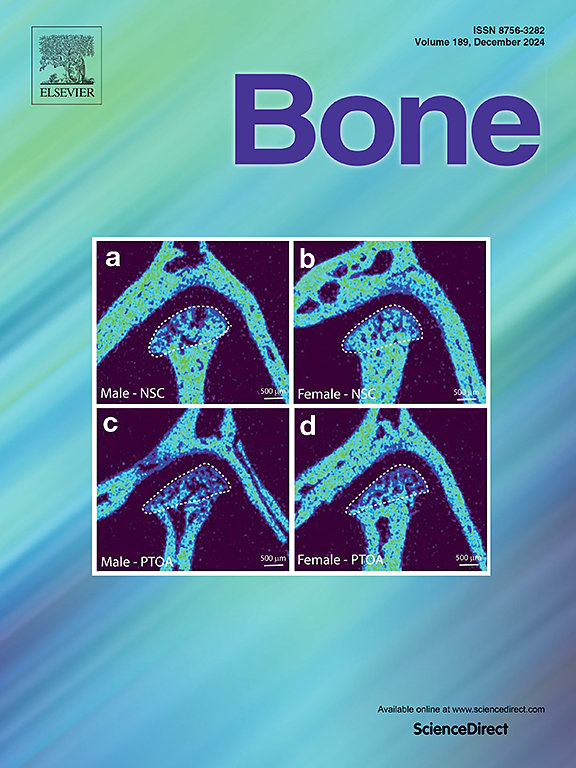在小鼠胫骨中逆向工程弗罗斯特力学模型:从PTH和机械载荷联合的见解
IF 3.6
2区 医学
Q2 ENDOCRINOLOGY & METABOLISM
引用次数: 0
摘要
骨质疏松症是一种影响数十亿人的广泛骨骼疾病,旨在增加骨量或防止骨质流失的治疗对于降低骨折风险和相关健康并发症至关重要。临床证据表明,间歇性甲状旁腺激素(PTH)治疗增加了某些骨骼部位的皮质宽度,当结合机械负荷(ML)时,效果进一步放大,使这种药物和运动方法有望用于双重骨质疏松症治疗。然而,甲状旁腺激素增强成骨反应的机制尚不完全清楚。本研究利用小鼠胫骨加载模型的μ CT端点成像数据,结合皮质骨应变模式的力学评估,定量计算Frost力学稳态模型的参数。特别是,我们研究了PTH单独和联合ML对骨形成阈值和速率的影响。我们的分析表明,PTH单独促进骨膜骨形成独立于应变模式诱导的习惯性负荷以剂量依赖的方式。甲状旁腺激素以剂量依赖性和部位特异性的方式降低骨形成模型阈值(MESm)。在胫骨高度的37%左右观察到最高的敏感性,在80μg/kg/天g甲状旁腺激素剂量下,MESm从未治疗骨的100.6 με下降到212.1με。该区域也表现出最高的适应响应,在80μg/kg/day PTH时,最大模拟速度(MaxFL)约为7με/day。尽管在所有地区,与未治疗的骨相比,pth治疗的骨的形成速度模数(FVM)增加,但这种变化并不依赖于剂量。本文章由计算机程序翻译,如有差异,请以英文原文为准。
Reverse engineering Frost's mechanostat model in mouse tibia: Insights from combined PTH and mechanical loading
Osteoporosis is a widespread skeletal disease impacting billions, with treatments aimed at enhancing bone mass or preventing bone loss essential for reducing fracture risk and related health complications. Clinical evidence shows that intermittent parathyroid hormone (PTH) treatment increases cortical width at certain skeletal sites, with effects further amplified when combined with mechanical loading (ML), making this pharmacological and exercise approach promising for dual osteoporosis therapy. However, the mechanisms through which PTH enhances osteogenic response are not fully understood. This study uses CT endpoint imaging data from the mouse tibia loading model together with mechanical assessment of strain patterns in cortical bone to quantitatively compute parameters in Frost's mechanostat model. Particularly, we investigate the effects of PTH alone and in combination with ML on bone formation threshold and rate. Our analysis shows that PTH alone promotes periosteal bone formation independently of strain patterns induced by habitual loading in a dose-dependent manner. PTH lowers the bone formation modeling threshold () in bones undergoing ML in a dose-dependent and site-specific manner. The highest sensitivity is observed around 37 % of tibial height, where decreases from in untreated bones to at an g/kg/day g PTH dose. This region also exhibits the highest adaptation response, with a maximum modeling velocity (MaxFL) of approximately /day at g/kg/day PTH. Although the formation velocity modulus (FVM) increases in PTH-treated bones compared to untreated ones across all regions, this change is not dose-dependent.
求助全文
通过发布文献求助,成功后即可免费获取论文全文。
去求助
来源期刊

Bone
医学-内分泌学与代谢
CiteScore
8.90
自引率
4.90%
发文量
264
审稿时长
30 days
期刊介绍:
BONE is an interdisciplinary forum for the rapid publication of original articles and reviews on basic, translational, and clinical aspects of bone and mineral metabolism. The Journal also encourages submissions related to interactions of bone with other organ systems, including cartilage, endocrine, muscle, fat, neural, vascular, gastrointestinal, hematopoietic, and immune systems. Particular attention is placed on the application of experimental studies to clinical practice.
 求助内容:
求助内容: 应助结果提醒方式:
应助结果提醒方式:


